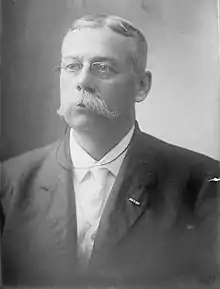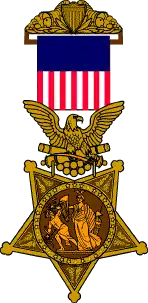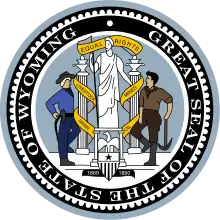Francis E. Warren
Francis Emroy Warren (June 20, 1844 – November 24, 1929) was an American politician of the Republican Party best known for his years in the United States Senate representing Wyoming and being the first Governor of Wyoming. A soldier in the Union Army during the American Civil War, he was the last veteran of that conflict to serve in the U.S. Senate.[1]
Francis E. Warren | |
|---|---|
 | |
| United States Senator from Wyoming | |
| In office November 24, 1890 – March 3, 1893 | |
| Preceded by | office established |
| Succeeded by | Clarence D. Clark |
| In office March 4, 1895 – November 24, 1929 | |
| Preceded by | Joseph M. Carey |
| Succeeded by | Patrick J. Sullivan |
| 1st Governor of Wyoming | |
| In office October 11, 1890 - November 24, 1890 | |
| Preceded by | Himself as Territorial Governor |
| Succeeded by | Amos W. Barber |
| Personal details | |
| Born | Francis Emroy Warren June 20, 1844 Hinsdale, Massachusetts, U.S. |
| Died | November 24, 1929 (aged 85) Washington, D.C., U.S. |
| Political party | Republican |
| Spouse(s) | Helen M. Smith (1871–1902; her death) Clara LeNaron Morgan (m. June 28, 1911–?) |
| Profession | Politician, farmer |
| Awards | Medal of Honor |
| Signature | |
| Military service | |
| Allegiance | Union |
| Branch/service | |
| Rank | |
| Unit | |
| Battles/wars | American Civil War |
Early life and military service
Warren was born on June 20, 1844 in Hinsdale, Berkshire County, Massachusetts, the son of Cynthia Estella (Abbott) and Joseph Spencer Warren.[2][3] He grew up attending common schools and his local Hinsdale Academy.
During the civil war, Warren served in the 49th Massachusetts Infantry as a noncommissioned officer. At the age of nineteen at the siege of Port Hudson, Warren received the Medal of Honor for battlefield gallantry. His entire platoon was destroyed by Confederate bombardment and Warren, taking a serious scalp wound, disabled the artillery. Warren later served as a captain in the Massachusetts Militia.
Medal of Honor citation

Rank and Organization: Corporal, Company C, 49th Massachusetts Infantry.
Place and Date: At Port Hudson, La., May 27, 1863.
Entered Service At: Hinsdale, Mass.
Birth: Hinsdale, Mass.
Date Of Issue: September 30, 1893.
Citation:
Personal life

Francis E. Warren married Helen Smith, a woman from Massachusetts, although all of their married life until his first election to the United States Senate, in 1890, was spent in Wyoming. They had two children, a daughter, Helen Frances, and a son, Frederick Emory. Helen Warren was the wife of General John J. Pershing. Mrs. Warren was the president of church, literary and charitable societies of Cheyenne, vice-president of the Foundling Hospital, and Daughter of the American Revolution.[6]
Business and politics
Following the civil war, Warren engaged in farming and stock-raising in Massachusetts before moving to Wyoming (then part of the Territory of Dakota) in 1868. Settling in Cheyenne, Warren engaged in real estate, mercantile business, livestock raising and the establishment of Cheyenne's first lighting system, becoming quite wealthy.
Warren's political work included: member, Wyoming Territorial Senate (1873–1874, 1884–1885), serving as senate president; member, Cheyenne City Council (1873–1874); treasurer of Wyoming (1876, 1879, 1882, 1884); and Mayor of Cheyenne (1885).
In February 1885, Warren was appointed Governor of the Territory of Wyoming by President Chester A. Arthur, although he was removed by Democratic President Grover Cleveland in November 1886. He was reappointed by President Benjamin Harrison in April 1889, and served until 1890, when he was elected first Governor of Wyoming (October 11, 1890 – November 24, 1890).
Senate years and death
In November 1890, Warren resigned as governor, having been elected to the United States Senate as a Republican, serving until March 4, 1893. He then resumed his former business pursuits before returning to the Senate (March 4, 1895–November 24, 1929). Warren chaired the following Senate Committees:
- - Committee on Irrigation and Reclamation of Arid Lands
- - Committee on Claims
- - Committee on Irrigation
- - Committee on Military Affairs
- - Committee on Public Buildings and Grounds
- - Committee on Agriculture and Forestry
- - Committee on Appropriations
- - Committee on Engrossed Bills
Warren died on November 24, 1929 in Washington, D.C. His funeral service was held in the United States Senate chamber. At the time of his death, he had served longer than any other U.S. senator.
Legacy
F. E. Warren Air Force Base in Cheyenne, Wyoming is named after Warren. Additionally, Warren's daughter married then-Captain John J. Pershing in 1905. Several years later, President Theodore Roosevelt promoted Pershing from captain to brigadier general over 900 senior officers. Pershing's wife and three daughters were later killed during a fire at the Presidio in San Francisco. Warren was also the first senator to hire a female staffer and, as appropriations chairman during World War I, he was instrumental in funding the American efforts. Warren and his second wife, Clara LaBarron Morgan, bought the Nagle Warren Mansion in April 1910, and their dining room hosted people such as presidents Teddy Roosevelt and William Howard Taft.[7][8] This mansion is now listed on the National Register of Historic Places.[9] In 1958, he was inducted into the Hall of Great Westerners of the National Cowboy & Western Heritage Museum.[10]
See also
References
- "United States Senate - Last Union Veteran". Retrieved June 4, 2013.
- Ragsdale, Margaret Tillotson (1998). "Tillotson, Tillison, and Tillitson: Descendants of John Tillotson, Immigrant to the American Colonies from the West Riding, Yorkshire, England : Landowner of Rowley and Newbury Colony of the Massachusetts Bay and One of the Thirty Founders of Lyme Colony of Connecticut in Two Volumes".
- Roberts, Gary Boyd; Reitwiesner, William Addams (1984). American Ancestors and Cousins of the Princess of Wales: The New England, Mid-Atlantic and Virginia Forebears, Near Relatives, and Notable Distant Kinsmen, Through Her American Great-grandmother, of Lady Diana Frances Spencer, Now Her Royal Highness the Princess of Wales. ISBN 9780806310855.
- ""Civil War Medal of Honor citations" (S-Z): WARREN, FRANCIS E." AmericanCivilWar.com. Retrieved November 13, 2013.
- "Medal of Honor website" (M-Z): WARREN, FRANCIS E." United States Army Center of Military History. Retrieved November 13, 2013.
- Hinman, Ida (1895). The Washington Sketch Book.
- "Nagle Warren Mansion Cheyenne, Wyoming". Historic Hotels. Archived from the original on December 4, 2017. Retrieved January 8, 2012.
- "Nagle Warren Mansion Hotel". Wyoming Tourism. Archived from the original on November 4, 2010. Retrieved January 8, 2012.
- "National Register Information System". National Register of Historic Places. National Park Service. July 9, 2010.
- "Hall of Great Westerners". National Cowboy & Western Heritage Museum. Retrieved November 22, 2019.
External links
| Wikimedia Commons has media related to Francis Emroy Warren. |
- United States Congress. "Francis E. Warren (id: W000164)". Biographical Directory of the United States Congress. Retrieved on 2008-02-01
- "Political Graveyard". Retrieved September 29, 2010.
- "Francis E. Warren". Claim to Fame: Medal of Honor recipients. Find a Grave. Retrieved February 1, 2008.
| Party political offices | ||
|---|---|---|
| First | Republican nominee for Governor of Wyoming 1890 |
Succeeded by Edward Ivinson |
| First | Republican nominee for U.S. Senator from Wyoming (Class 2) 1918, 1924 |
Succeeded by Robert D. Carey |
| Political offices | ||
| Preceded by Joseph M. Carey |
Mayor of Cheyenne, Wyoming 1885 |
Succeeded by ' |
| Preceded by Elliot S.N. Morgan |
Governor of Wyoming Territory 1885–1886 |
Succeeded by George W. Baxter |
| Preceded by Thomas Moonlight |
Governor of Wyoming Territory 1889–1890 |
Succeeded by Himself as state Governor |
| Preceded by Himself as Territorial Governor |
Governor of Wyoming October 11, 1890 - November 24, 1890 |
Succeeded by Amos W. Barber |
| U.S. Senate | ||
| Preceded by (none) |
U.S. Senator (Class 1) from Wyoming November 18, 1890 – March 4, 1893 |
Succeeded by Clarence D. Clark |
| Preceded by Joseph M. Carey |
U.S. Senator (Class 2) from Wyoming March 4, 1895 – November 24, 1929 |
Succeeded by Patrick J. Sullivan |
| Honorary titles | ||
| Preceded by Henry Cabot Lodge |
Dean of the United States Senate November 9, 1924 – November 24, 1929 |
Succeeded by Furnifold M. Simmons |
| National Rifle Association | ||
| Preceded by Smith W. Brookhart |
President of the NRA 1925 |
Succeeded by Smith W. Brookhart |

